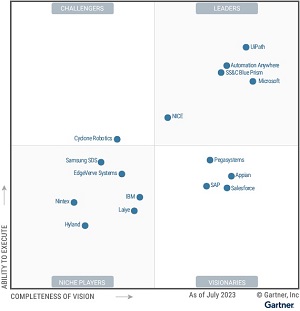News
AI Powers Microsoft to Leadership in Robotic Process Automation
Microsoft's big bet on advanced AI is paying off in many ways, including propelling the company into the leadership rank of a research report on robotic process automation (RPA).
The company famously made a $10 billion-plus investment in OpenAI, creator of ChatGPT, and has infused the resulting AI tech throughout its products and services, reportedly leading to an additional $31 billion in revenue.
AI also might account for Microsoft being the sole cloud giant named a "Leader" in a recent "Magic Quadrant" report on RPA from research firm Gartner. In fact, it's the only cloud giant covered in the report, giving Redmond another edge in its competition with Amazon Web Services (AWS) and Google Cloud. Other major industry players including IBM, SAP and Salesforce were included, but not AWS or Google.
Gartner listed Microsoft's AI focus among the "strengths" of its RPA offering: "Its RPA product, Power Automate, is built on Azure and enables cloud-first and API-first automation, along with desktop-based automation via Power Automate for desktop (PAD). Power Automate provides RPA with API integration and orchestration, IDP, task and process mining, optical character recognition (OCR) and AI."
AI is a natural fit for RPA, which the research firm describes as software to automate tasks within business and IT processes via software scripts that emulate human interaction with the application UI. That sounds a lot like a bill fitted with ChatGPT and other advanced AI constructs.
"Microsoft has embedded Microsoft 365 Copilot, its generative AI component, within Power Automate," Gartner said in the "Magic Quadrant for Robotic Process Automation" report, revised just yesterday (Aug. 24). "Microsoft's investment in LLMs and partnerships with third-party products such as OpenAI's ChatGPT are intended to disrupt the market. Microsoft plans to use LLMs and other models to easily create automations for richer workloads."
Those plans apparently propelled Microsoft to the extreme end of the "completeness of vision" axis, though the company is behind several other "Leaders" on the "ability to execute" axis.
 [Click on image for larger view.] Magic Quadrant for Robotic Process Automation (source: Gartner).
[Click on image for larger view.] Magic Quadrant for Robotic Process Automation (source: Gartner).
While strengths of Power Automate -- along with the aforementioned AI focus -- include the Microsoft ecosystem and its pricing/sales strategy, the research firm's "cautions" include clarity of RPA offering, integration with legacy back office and cloud-first RPA orchestration.
"Microsoft's operations are geographically distributed," the report said. "Its customer base includes large enterprises and SMBs. Microsoft's RPA product roadmap includes reusable UI element collectors as components within the Power Automate designer studio. Microsoft will make additional cloud connectors available in the desktop flow designer and picture-in-picture execution for attended automation as a digital assistant in a user's desktop."
As for the market in general, Gartner said RPA is used across numerous business functions for tactical task automation, noting that business and IT users can leverage RPA to:
- Move data in or out of application systems without human interaction (unattended automation). Scripts are designed to replicate the actions of a person interacting with those systems or documents, which usually do not have available APIs. The goal is to automate and complete a task successfully without human intervention. Typically, unattended automation is triggered by a system and bots executed on a server.
- Automate tasks with a human in the loop (attended automation). RPA can extract information from systems and related documents, shaping it and preparing it for consumption by a human at the point of need. Typically, attended automation is triggered by a human and bots executed on a local device.
The research firm also noted the growing trend of API-first and cloud-first automation and discussed how ChatGPT and other machine learning large language models (LLMs) are driving AI-generated automation.
"As is evident in every aspect of business and IT, ChatGPT and LLMs are profoundly impacting automation," Gartner said. "Almost every RPA vendor has either already experimented, or plans to experiment, with including GPT models in their products or enabling APIs to known GPT vendors such as OpenAI. They are also offering direct capabilities, such as automatic email generation, prompts within workflow design, more accurate IDP model training, process-mining analytics and AI-driven development of RPA scripts. Many RPA vendors will launch incremental capabilities in the next one or two years, making AI-generated automation an important capability."
Gartner's Magic Quadrant reports are commonly available for free in licensed-for-distribution editions disseminated by the covered vendors, this one being easily found with a quick web search for "Magic Quadrant for Robotic Process Automation."
About the Author
David Ramel is an editor and writer at Converge 360.